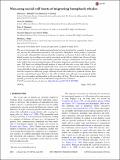Files in this item
Non-song social call bouts of migrating humpback whales
Item metadata
| dc.contributor.author | Rekdahl, Melinda | |
| dc.contributor.author | Dunlop, Rebecca | |
| dc.contributor.author | Goldizen, Anne | |
| dc.contributor.author | Garland, Ellen Clare | |
| dc.contributor.author | Biassoni, Nicoletta | |
| dc.contributor.author | Miller, Patrick | |
| dc.contributor.author | Noad, Michael | |
| dc.date.accessioned | 2015-12-01T00:12:08Z | |
| dc.date.available | 2015-12-01T00:12:08Z | |
| dc.date.issued | 2015-06 | |
| dc.identifier | 198197673 | |
| dc.identifier | 77835313-516a-4d1d-93c9-b73312a73db3 | |
| dc.identifier | 84934926480 | |
| dc.identifier | 000356622400022 | |
| dc.identifier.citation | Rekdahl , M , Dunlop , R , Goldizen , A , Garland , E C , Biassoni , N , Miller , P & Noad , M 2015 , ' Non-song social call bouts of migrating humpback whales ' , Journal of the Acoustical Society of America , vol. 137 , no. 6 , pp. 3042-3053 . https://doi.org/10.1121/1.4921280 | en |
| dc.identifier.issn | 0001-4966 | |
| dc.identifier.other | ORCID: /0000-0002-8240-1267/work/49580211 | |
| dc.identifier.uri | https://hdl.handle.net/10023/7875 | |
| dc.description | This work was funded by the E&P Sound and Marine Life Joint Industry Programme (JIP), managed by the International Association of Oil and Gas Producers (OGP), the U.S. Bureau of Ocean Energy Management (BOEM), and the U.S. Office of Naval Research (ONR) with additional in-kind support from the Australian Defence Science and Technology Organisation. | en |
| dc.description.abstract | The use of stereotyped calls within structured bouts has been described for a number of species and may increase the information potential of call repertoires. Humpback whales produce a repertoire of social calls, although little is known about the complexity or function of these calls. In this study, digital acoustic tag recordings were used to investigate social call use within bouts, the use of bouts across different social contexts, and whether particular call type combinations were favored. Call order within bouts was investigated using call transition frequencies and information theory techni- ques. Call bouts were defined through analysis of inter-call intervals, as any calls within 3.9 s of each other. Bouts were produced significantly more when new whales joined a group compared to groups that did not change membership, and in groups containing multiple adults escorting a female and calf compared to adult only groups. Although social calls tended to be produced in bouts, there were few repeated bout types. However, the order in which most call types were produced within bouts was non-random and dependent on the preceding call type. These bouts appear to be at least partially governed by rules for how individual components are combined. | |
| dc.format.extent | 900275 | |
| dc.language.iso | eng | |
| dc.relation.ispartof | Journal of the Acoustical Society of America | en |
| dc.subject | QH301 Biology | en |
| dc.subject | NDAS | en |
| dc.subject.lcc | QH301 | en |
| dc.title | Non-song social call bouts of migrating humpback whales | en |
| dc.type | Journal article | en |
| dc.contributor.institution | University of St Andrews. School of Biology | en |
| dc.contributor.institution | University of St Andrews. Sea Mammal Research Unit | en |
| dc.contributor.institution | University of St Andrews. Centre for Social Learning & Cognitive Evolution | en |
| dc.contributor.institution | University of St Andrews. Centre for Biological Diversity | en |
| dc.identifier.doi | 10.1121/1.4921280 | |
| dc.description.status | Peer reviewed | en |
| dc.date.embargoedUntil | 2015-12-01 |
This item appears in the following Collection(s)
Items in the St Andrews Research Repository are protected by copyright, with all rights reserved, unless otherwise indicated.

